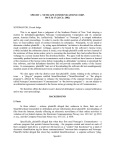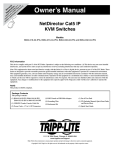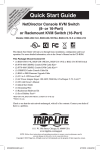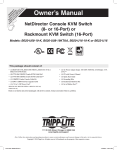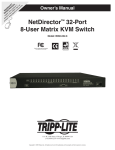Download Tripp Lite B022-U08-IP User's Manual
Transcript
pr ch re R W od an gi uc ce ste eg arr t— to r o is a w w nli tra nty w in n w. a e tio tri F to n pp R da : lit EE y f e. T o co ri r a m pp /w L ar ite ra nt y Quick Start Guide NetDirector™ 1U Rackmount KVM Switch with IP Access Model # B022-U08-IP 1111 W. 35th Street, Chicago, IL 60609 USA • www.tripplite.com/support Copyright © 2013 Tripp Lite. All rights reserved. All trademarks are the property of their respective owners. The policy of Tripp Lite is one of continuous improvement. Specifications are subject to change without notice. 1 1. FCC Information This is an FCC Class A product. In a domestic environment this product may cause radio interference in which case the user may be required to take adequate measures. This equipment has been tested and found to comply with the limits for a Class A digital device, pursuant to Part 15 of the FCC Rules. These limits are designed to provide reasonable protection against harmful interference when the equipment is operated in a commercial environment. This equipment generates, uses and can radiate radio frequency energy and, if not installed and used in accordance with the instruction manual, may cause harmful interference to radio communications. Operation of this equipment in a residential area is likely to cause harmful interference in which case the user will be required to correct the interference at his own expense. 2. User Notice All information, documentation and specifications contained in this manual are subject to change without prior notification by the manufacturer. The manufacturer makes no representations or warranties, either expressed or implied, with respect to the contents hereof and specifically disclaims any warranties as to merchantability or fitness for any particular purpose. Any of the manufacturer’s software described in this manual is sold or licensed “as is.” Should the programs prove defective following their purchase, the buyer (and not the manufacturer, its distributor or its dealer), assumes the entire cost of all necessary servicing, repair and any incidental or consequential damages resulting from any defect in the software. The manufacturer of this system is not responsible for any radio and/or TV interference caused by unauthorized modifications to this device. It is the responsibility of the user to correct such interference. The manufacturer is not responsible for any damage incurred in the operation of this system if the correct operational voltage setting was not selected prior to operation. PLEASE VERIFY THAT THE VOLTAGE SETTING IS CORRECT BEFORE USE. 3. Package Contents This package consists of: • B022-U08-IP KVM Switch • External Power Supply • 6 ft. USB/PS2 Combo KVM Cable Kits (x2) • Rubber Feet • USB/PS2 Combo Console Cable Kit • CD with Owner’s Manual, Quick Start Guide and Device Files • RJ11 to DB9 Firmware Upgrade Cable • Quick Start Guide • Rackmount Hardware Check to make sure that all of the components are present and in good order. If anything is missing, or was damaged in shipping, contact your dealer. Read this manual thoroughly and follow the installation and operation procedures carefully to prevent any damage to the switch or to any other devices in the installation. 4. Introduction 4.1 Features • • • • • • • • • • • • • • • • • • • • 1U Rackmount KVM Switch with built-in IP access. Connect either USB or PS/2 computers using P778-Series USB/PS2 Combo KVM Cable Kits – no need for separate cable kits. Control up to 8 computers on a single KVM switch. Daisychain multiple KVM switches together to increase the number of connected computers. An additional 15 KVM switches can be daisychained from the B022-U08-IP for a total of 248 connected computers. Remotely access computers via LAN, WAN or Internet via the Windows™ or Java browser clients. AP Windows and Java Clients allow the KVM to be remotely accessed via the network without going through a browser. External USB 1.1 port allows USB peripheral devices to be shared amongst connected computers. Grayscale feature allows you to view remote sessions in black and white, reducing the amount of data traveling over the network and improving keyboard/mouse response time over IP. Web management interface, OSD and toolbars provide convenient, user-friendly operation. 3-level security (Admin, User and Select) – up to 64 accounts can be created. Panel Array Mode – remotely monitor multiple ports at the same time. Message board feature allows users who are logged in at the same time to communicate with each other and manage port access. CD includes a Windows-based log server that records events on the installation and writes them to a searchable database. Supports RADIUS and LDAP/S authentication. Flash firmware upgradable via network and included firmware upgrade cable. Supports both IPv4 and IPv6. Supports Link Local IPv6 Address and IPv6 Stateless Auto configuration protocol. Web Management Interface, Remote OSD and Local OSD can be displayed in English, Spanish, French, German and Japanese. Advanced encryption technologies: 128-bit SSL, 128-bit RC4, 1024-bit RSA, 56-bit DES, 256-bit AES, 168-bit 3DES. Video resolutions up to 2048 x 1536, DDC2B are supported at the local console. Video resolutions up to 1600 x 1200 @ 60Hz, 24-bit color depth are supported at the remote console. 2 4. Introduction (continued) 4.2 System Requirements 4.2.3 Remote Console 4.2.1 External Console • A VGA, SVGA or MultiSync monitor capable of displaying the highest resolution provided by any computer in the installation. • For best results, computers that remotely access the KVM switch should have at least a Pentium III 1 GHz processor. • PS/2 or USB keyboard and mouse. • Users who want to access the KVM switch with the Windows Client must have DirectX 8.0 or higher installed. DirectX is available for free download from Microsoft’s Website: http://www.microsoft.com/downloads. 4.2.2 Computers The following equipment must be installed on each computer: • Users who want to access the KVM switch with the Java Client must have Sun’s Java 6 (update 3 or higher) runtime environment installed. Java is available for free download from the Sun Java Website: http://java.com. • A VGA, SVGA or MultiSync video graphics card with an HD15 port. Either: • PS/2 mouse and keyboard ports (6-pin Mini-DIN). • For best results, a network transfer speed of at least 128 Kbps is recommended. • USB port. • Browsers must support 128-bit data encryption. • To run the Log Server, you must have the Microsoft Jet 0LED8 4.0 (or higher) driver installed. 4.2.4 Supported Browsers Browser Versions Supported Internet Explorer 6 and higher Firefox 1.5 and higher Mozilla 1.7 and higher Safari 4.0 and higher Opera 9.0 and higher Netscape 8.1 and higher 4.2.5 Custom KVM Cable Kits The B022-U08-IP uses custom P778-Series USB/PS2 Combo KVM Cable Kits, which can be used to connect to a computer with either USB or PS/2 connectors. One cable kit is required for each connected computer. 4.2.6 Operating Systems Supported operating systems are shown in the table, below: Operating System Windows Linux RedHat Linux Fedora Linux SuSE Linux Mandriva (Mandrake) UNIX AIX Versions Supported 2000 and higher 7.1 and higher Core 5 and higher 9.0 and higher 9.0 and higher 3.51 and higher Operating System UNIX Free BSD UNIX Sun Novell Netware Mac DOS 3 Versions Supported 3.51 and higher Solaris 8 and higher 5.0 and higher OS 9 and higher 6.2 and higher 4. Introduction (continued) 4.3 Components 4.3.1 Front View 1 2 1 3 Port Selection Pushbuttons: These buttons toggle between the computers attached to the corresponding KVM ports. 4 4 • Simultaneously pressing and holding buttons 1 and 2 for three seconds will perform a keyboard / mouse reset. Port LEDs: The Port LEDs are built into the Port Selection Pushbuttons. • An Online LED on the left side of the pushbutton will illuminate Orange to indicate that a powered-on computer is connected to the corresponding port. • A Selected LED on the right side of the pushbutton will illuminate Green to indicate that the corresponding port has the focus of the KVM. 3 6 7 8 USB Peripheral Port: A USB 1.1 port is provided for the sharing of USB peripherals among connected computers (e.g. flash drive, CD-ROM drive, etc.). Note: USB peripherals can only be shared among computers that are connected to the KVM switch via the USB connectors on the P778-Series USB/PS2 Combo KVM Cable Kit. • Simultaneously pressing and holding buttons 7 and 8 for three seconds will initiate an Auto Scan. 2 5 Reset Button: Press this recessed button with a thin object to perform a system reset. 5 Firmware Upgrade Switch: During a firmware upgrade, as well as normal operation, this switch should be in the NORMAL position. If a firmware upgrade does not perform successfully, this switch is flipped to the RECOVER position during the firmware upgrade recovery process. 6 Firmware Upgrade Port: The RJ11 connector on the included firmware upgrade cable connects to the KVM switch here. 7 Power LED: The Power LED illuminates blue to indicate the unit is receiving power. 8 Station ID LED: The Station ID LED will display the number of the station that currently has the console’s focus. 4.3.2 Rear View 1 3 1 4 5 6 7 2 Daisychain-Out Port: A P772-Series Daisychain Cable (sold separately) connects between this port and the Daisychain-In Port on a B022-U16 or B022-016 KVM switch to expand the number of connected computers. 2 KVM Ports: The custom wired KVM cable kits that connect to the computers plug in here. 3 Grounding Terminal: The wire (user provided) used to ground the B022-U08-IP connects to the KVM here. 4 Cable Tie Slot: A cable tie can be routed through this slot in order to tie the connected cables together for organizational purposes. 4 5 Power Jack: The included power supply connects to the KVM here. 6 LAN Port: The cable that connects the KVM switch to a LAN, WAN or Internet plugs in here. 7 Console Port: The included USB/PS2 Combo Console Cable Kit connects to the KVM switch here, allowing you to attach a VGA monitor and USB or PS/2 keyboard/mouse. 5. Installation 5.1 General Safety Instructions • Read all of these instructions. Save them for future reference. • Follow all warnings and instructions marked on the device. • Do not place the device on any unstable surface (cart, stand, table, etc.). If the device falls, serious damage will result. • Do not use the device near water. • Do not place the device near, or over, radiators or heat registers. • The device cabinet is provided with slots and openings to allow for adequate ventilation. To ensure reliable operation, and to protect against overheating, these openings must never be blocked or covered. • The device should never be placed on a soft surface (bed, sofa, rug, etc.) as this will block its ventilation openings. Likewise, the device should not be placed in a built in enclosure unless adequate ventilation has been provided. • Never spill liquid of any kind on the device. • Unplug the device from the wall outlet before cleaning. Do not use liquid or aerosol cleaners. Use a damp cloth for cleaning. • The device should be operated from the type of power source indicated on the marking label. If you are not sure of the type of power available, consult your dealer or local power company. • This device is designed for IT power distribution systems with up to 230V phase-to-phase voltage. • The device is equipped with a 3-wire grounding type plug. This is a safety feature. If you are unable to insert the plug into the outlet, contact your electrician to replace your obsolete outlet. Do not attempt to defeat the purpose of the grounding-type plug. Always follow your local/national wiring codes. • Do not allow anything to rest on the power cord or cables. Route the power cord and cables so that they cannot be stepped on or tripped over. • If an extension cord is used with this device make sure that the total of the ampere ratings of all products used on this cord does not exceed the extension cord ampere rating. Make sure that the total of all products plugged into the wall outlet does not exceed 15 amperes. • Consideration should be given to the connection of equipment to the supply circuit, and what effect overloading the supply circuit might have on overcurrent protection and supply wiring. • To help protect your system from sudden, transient increases and decreases in electrical power, use a Tripp Lite Surge Suppressor, Line Conditioner or Uninterruptible Power Supply (UPS). • Position system cables and power cables carefully; be sure that nothing rests on any cables. • When connecting or disconnecting power to hot-pluggable power supplies, observe the following guidelines: • Install the power supply before connecting the power cable to the power supply. • Unplug the power cable before removing the power supply. • If the system has multiple sources of power, disconnect power from the system by unplugging all power cables from the power supplies. • Never push objects of any kind into or through cabinet slots. They may touch dangerous voltage points or short out parts resulting in a risk of fire or electrical shock. • Do not attempt to service the device yourself. Refer all servicing to qualified service personnel. • If the following conditions occur, unplug the device from the wall outlet and bring it to qualified service personnel for repair: • The power cord or plug has become damaged or frayed. • Liquid has been spilled into the device. • The device has been exposed to rain or water. • The device has been dropped, or the cabinet has been damaged. • The device exhibits a distinct change in performance, indicating a need for service. • The device does not operate normally when the operating instructions are followed. • Only adjust those controls that are covered in the operating instructions. Improper adjustment of other controls may result in damage that will require extensive work by a qualified technician to repair. • Use of this equipment in life support applications where failure of this equipment can reasonably be expected to cause the failure of the life support equipment or to significantly affect its safety or effectiveness is not recommended. Do not use this equipment in the presence of a flammable anesthetic mixture with air, oxygen or nitrous oxide. Rack Mounting Safety Instructions • The ambient operating temperature in the rack may be an issue and is dependent upon the rack load and ventilation. When installing in a closed or multi-unit rack assembly, make sure that the temperature will not exceed the maximum rated ambient temperature. • Before working on the rack, make sure that the stabilizers are secured to the rack, extended to the floor, and that the full weight of the rack rests on the floor. Install front and side stabilizers on a single rack or front stabilizers for joined multiple racks before working on the rack. • Always load the rack from the bottom up, and load the heaviest item in the rack first. • Always load the rack so that a hazardous condition is not created due to uneven loading. • Make sure that the rack is level and stable before extending a device from the rack. • Use caution when pressing the device rail release latches and sliding a device into or out of a rack; the slide rails can pinch your fingers. • After a device is inserted into the rack, carefully extend the rail into a locking position, and then slide the device into the rack. • Do not overload the AC supply branch circuit that provides power to the rack. The total rack load should not exceed 80% of the branch circuit rating. • Ensure that proper airflow is provided to devices in the rack. • Do not step on or stand on any device when servicing other devices in a rack. • Do not connect the RJ11 connector marked “Upgrade” to a public telecommunication network. • Caution! Slide/Rail (LCD KVM) mounted equipment is not to be used as a shelf or a work space. CAUTION! Slide/rail-mounted equipment is not to be used as a shelf or a workspace. 5 5. Installation (continued) 5.2 Rack Mounting Instructions Standard Rack Mounting 1. Depending on whether you want to mount the KVM switch to the front or back of the rack, attach the included rackmount brackets to the front or rear sides of the KVM switch. 2. Using user-supplied screws, mount the rackmount brackets of the KVM switch to the rack. 5.3 Grounding To prevent damage to your installation, it is important that all devices are properly grounded. Using a user-supplied grounding wire, ground the KVM switch by connecting one end of the wire to the grounding terminal on the unit, and the other end of the wire to a suitably grounded object. 5.4 Single Stage Installation In a single stage installation, there are no additional KVM switches daisy-chained from the master KVM. To set up a single stage installation, refer to the following steps and installation diagram. 6 5 2 3 3 Connect a P778-Series USB/PS2 Combo KVM Cable Kit between an available KVM port on the back of the unit and a computer/ server. P778-Series Cable Kits allow you to connect to a computer with either USB or PS/2* keyboard/mouse ports, without the need for separate cables. Note: The distance between the KVM and the connected computer must not exceed 33 ft. (10 m). 4 Repeat step 3 for each additional computer you wish to connect. 5 Connect the LAN port on the back of the unit to the network using Cat5e/6 cable. 6 Connect the included external power supply to the B022-U08IP, and then plug it into a Tripp Lite Surge Suppressor, PDU or Uninterruptible Power Supply (UPS). After the KVM switch powers up, power on the connected computers. 4 1 Power OFF all computers that are being connected to the KVM switch. 7 2 Add an external console to the KVM by connecting the included USB/PS2 console cable kit to the console port on the back of the unit, and then connecting an external monitor (HD15), keyboard (USB or PS/2) and mouse (USB or PS/2) to the connectors on the cable kit. *When connecting to computers using the PS/2 connectors of a P778-Series Cable Kit, the Mouse Sync Mode setting must be set to Manual in order to access the computer over IP. If Mouse Sync Mode is set to Automatic, you will not have mouse functionality when accessing that computer over IP. This setting is set to Manual by default. 6 5. Installation (continued) 5.5 Multi-Stage Daisy-chain Installation The number of connected computers can be increased by daisy-chaining additional B022-016 or B022-U16 KVM Switches. An additional 15 KVM switches can be added for a total of 248 connected computers. 1 Power OFF all computers that are being connected to the KVM switch. 2 Using a P772-Series Daisy-Chain Cable (sold separately), connect the Chain Out port on the back of the first stage KVM to the Chain In port on the back of the next stage KVM. The distance between any two KVM switches in a daisy-chain must not exceed 49 ft. (15 m). The distance between the first KVM switch and the last KVM switch in a daisy-chain must not exceed 328 ft. (100 m), regardless of the number of KVM switches in the entire chain. 3 Repeat step 2 for each additional KVM switch you wish to add to the installation, with a maximum of 16 levels. 4 Connect a P778-Series USB/PS2 Combo KVM Cable Kit between an available KVM port and a computer/server. P778-Series Cable Kits allow you to connect to a computer with either USB or PS/2* keyboard/mouse ports, without the need for separate cables. Note: The distance between the KVM and the connected computer must not exceed 33 ft. (10 m). 5 Repeat step 4 for each additional computer/server you wish to add to the installation. 6 Connect the included external power supply to the B022-U08IP, and then plug it into a Tripp Lite Surge Suppressor, PDU or Uninterruptible Power Supply (UPS). Turn on the first stage KVM switch. The Station ID on the KVM’s keyboard panel will display 01. 7 Connect the external power supply included with the next stage KVM switch and plug it into a Tripp Lite Surge Suppressor, PDU or Uninterruptible Power Supply (UPS). The Station ID on the KVM’s front panel will display 02. 8 Repeat step 7 for each subsequent KVM switch in the installation. In each case, wait for the previous KVM switches Station ID to be displayed before connecting the power cord to the next KVM switch. 9 Power ON the connected computers. B022-U08-IP *When connecting to computers using the PS/2 connectors of a P778-Series Cable Kit, the Mouse Sync Mode setting must be set to Manual in order to access the computer over IP. If Mouse Sync Mode is set to Automatic, you will not have mouse functionality when accessing that computer over IP. This setting is set to Manual by default. 5.6 Network Setup-IP Address Configuration In order to configure a fixed IP address, you will need to access the KVM switch in one of four ways; Local Console, IP Installer, Browser or NonBrowser Clients. 5.6.1 Local Console Note: The local console OSD only allows you to configure IPv4 network settings. For IPv6, access the Web Management Interface or Remote Session OSD. 1. When accessing the KVM switch for the first time, a prompt will appear asking for a Username and Password. The default Username is administrator, and the default Password is password. For security purposes, it is strongly recommended that you change the username and password on this account to something unique. When you have entered your username and password, the OSD will appear with the following page displayed. 7 5. Installation (continued) 5.6.1 Local Console (continued) 2. Press the [F4] key to bring up the OSD Admin page. 3. In the OSD Admin page, highlight SET IP ADDRESS and press the [Enter] key. 4. DHCP – The first field allows you to enable or disable DHCP. When enabled, the KVM is assigned an IP address by the DHCP server. This setting is enabled by default. To disable the DHCP setting and set up a fixed IP address, press the [Spacebar] key. Once the DHCP is disabled, you will be allowed to edit the remaining fields in the SET IP ADDRESS screen. 5. In the remaining fields, enter in the IP address, subnet mask and default gateway you want to assign to the KVM switch. 6. Press the [Esc] key to exit the SET IP ADDRESS screen, and to pull up a prompt asking if you wish to save the settings you just entered. If you do not wish to save the settings, press the [N] key. If you do wish to save the settings, press the [Y] key. Upon pressing the [Y] key, the settings will be saved and the KVM will be reset. 5.6.2 IP Installer The CD that comes with the product includes a Windows-based IP Installer utility that can be used to obtain and edit the IP address assigned to the KVM. To use the IP Installer utility, the computer you are using must be running a Windows operating system, and must be on the same network as the KVM. Also, the IP Installer setting in the Network page of the Web Management Interface must be set to Enabled, which it is by default. 3. Select your KVM from the Device List. Note: If the list is empty, or your device doesn’t appear, click the Enumerate button to refresh the Device List. If there is more than one device in the list, use the MAC address on the bottom of your unit to determine the desired device. 4. To assign a fixed IP address, check the Use the following IP address checkbox and fill in the IP Address, Subnet Mask, and Default Gateway fields with information appropriate for your network (IPv4 or IPv6). Note: The IP Installer settings can only be accessed via the browserbased Web Management Interface. They are not accessible in the Remote OSD. 5. Click the Set IP button to apply the changes to the unit. The new IP address will appear in the Device List. 1. Save the IP Installer.exe file from the CD to a desired location on a computer that is on the same network as the KVM. 6. Click the Exit button to exit the IP Installer utility. 2. Locate the IP Installer.exe file that you just saved and double-click on it. A screen similar to the one below will appear: 5.6.3 Browser By default, the B022-U08-IP is set to have an IP address assigned automatically via DHCP server. If this is the case, you will need to obtain the IP address from your network administrator. If connected to a network without a DHCP server, it boots with a default IP address. The default IPv4 and IPv6 addresses can be found on the sticker on the bottom of the unit. 1. Enter the unit’s IP address into your web browser. 2. You may be prompted by a screen stating that there is a problem with this website’s security certificate. Click on the option to continue to the website anyway. (See Web Browser Login section for details on installing the security certificate) 3. You will be brought to a login page. Enter the default User Name (administrator), and the default Password (password). The Web Management Interface will open upon entering the User Name and Password. 8 5. Installation (continued) 5.6.3 Browser (continued) 4. Click on the Network icon at the top of the page to bring up the Network settings page. 5. By default, the Obtain IP address automatically [DHCP] checkbox is checked. To set a fixed IP address, check the Set IP address manually [Fixed IP] check box in the IPv4 or IPv6 settings section, depending on your network. 6. The IP Address, Subnet Mask and Default Gateway fields will be activated upon checking the Set IP address manually [Fixed IP] checkbox. Fill in these fields with information appropriate for your network. 7. As with the IP Address settings, the DNS Server settings can be obtained automatically or assigned manually. To manually enter these settings, check the Set DNS server address manually checkbox and fill in the Preferred DNS server and Alternate DNS server fields with information appropriate for your network. Note: The Alternate DNS server field is optional. 8. When you have entered the IP Address and DNS Server settings, click the Apply button. Clicking the Apply button will automatically check the Reset on exit checkbox located in the Customization page of the Web Management Interface. When you log out, the unit will be reset and your network changes will be applied. See the Network Settings section in the Owner’s Manual for complete information on the rest of the settings in this page. 5.6.4 Non-Browser Clients 4. If you are on the same network as the KVM, the client will locate it and display it in the Device List. In this case, highlight the unit in the Device List and click the Login button. If you are not on the same network as the unit, it will not be displayed in the list. You must manually enter the IP address in the IP Address field, and then click the Login button. The CD that comes with the product includes Windows and Java Client applications that allow you to remotely access the KVM without using a web browser. The applications function the same, but the Windows Client is designed for Windows computers, whereas the Java client is designed for either Windows or non-Windows computers. When accessed from a computer that is on the same network as the KVM, the client will search the network for the device and display it in a device list for you to access. If accessed from a computer that is not on the same network as the KVM, you must obtain the IP address from your network administrator and manually enter it into the client. (See the Browser section above for information on obtaining the IP address) To use the Windows or Java client to assign a fixed IP address, follow the steps below. 5. Upon clicking the Login button, you will be prompted to enter in a Username and Password. Enter the default User Name (administrator), and the default Password (password). The Logout button, and the Remote View and Change Password buttons on the right of the non-browser client main page will be activated. The Login button will be deactivated. 1. Save the Windows or Java client from the CD to a desired location on your computer. Double-click the file to open it. 2. When accessing the Windows Client for the first time, it will need to be installed on your computer. Follow the installation prompts that appear. Once installed, a Windows Client icon will appear on your desktop. 3. When accessing either the Windows or the Java client for the first time, you will be prompted to enter the product serial number, which can be found on the CD that came with the unit. Once entered, you will not be prompted for it again. The non-browser client connection screen appears. 9 5. Installation (continued) 5.6.4 Non-Browser Clients (continued) 7. Click on the Administration tab at the top of the screen. On this page, click on the Network Icon to pull up the Network page. From here, a fixed IP address can be assigned in the same way as when using a web browser (See steps 5 through 8 in the Browser section). 6. Click the Remote View button to initiate a remote session, which will open with the remote OSD displayed. The remote OSD contains most of the features that are contained in the Web Management Interface, but it is presented in a different format. 6. KVM Operation 6.1 Local Console Login When accessing the console KVM switch for the first time, a prompt will appear asking for a username and password. The default username is administrator, and the default password is password. For security purposes, it is strongly recommended that you change the username and password on this account to something unique. Once the KVM has been set up and user accounts have been created, the login prompt will only appear when a user logs out of the KVM. When you have entered your username and password, the OSD will appear with the following page displayed. Note: 1. The screenshot depicts the Administrator’s Main Screen. The User Main Screen does not have the F4 and F6 functions, since they can’t be accessed by ordinary Users and are reserved for the Administrator. 2. OSD always starts in List view, with the highlight bar at the same position it was when the OSD was last closed. 3. Only the ports that have been set accessible by the Administrator for the currently logged in User are visible. 4. If the port list is collapsed into stations, simply click on the plus sign next to the desired station number, or highlight the desired station number and hit the [Enter] key. 6.2 Local Console Port Access Once logged into the KVM, you can access connected computers via the local console using the Local Console OSD, Local Console Pushbuttons or Hotkey Commands. 6.2.1 Local Console OSD Invocation Sequence Once logged into the KVM switch and accessing a connected computer, you will need to use one of two sequences to re-open the OSD Main Menu; [Scroll Lock, Scroll Lock] or [Ctrl, Ctrl]. The default OSD invocation sequence is [Scroll Lock, Scroll Lock]. 10 6. KVM Operation (continued) 6.2.2 Local Console OSD Navigation When in the Local Console OSD, you can use your keyboard and mouse to access its features. • To close out of the Local Console OSD, click the [X] at the upper right corner of the OSD or press the [Esc] key. • To logout, press the [F8] key, click the F8 at the top of the OSD, or click the zZz symbol in the upper right hand corner of the OSD. • To move through the OSD list one line at a time, click the up and down triangle symbols ( , ) or use the [ ] and [ ] keyboard keys. If there are more entries than appear on the screen, the screen will scroll. • To move up or down one screen at a time, click the Up and Down Arrow symbols ( , ), or use the [Pg Up] and [Pg Dn] keyboard keys. If there are more entries than appear on the screen, the screen will scroll. • To activate a port, double-click it, or highlight it and press the [Enter] key. Once a port is accessed, the OSD will close and the screen of the computer connected to the port will be displayed. 6.3 Logging Into the KVM over IP There are three methods that can be used to connect to the KVM switch over IP; Web Browser, AP Windows Client and AP Java Client. 6.3.1 Logging In via Web Browser 3. If accessing the KVM for the first time, enter in the username administrator and the password password. For security purposes, it is strongly recommended that you change the username and password on this account to something unique. When you have entered your username and password, the KVM web interface will appear with the following page displayed: 1. Open your web browser and type in the IP address of the KVM. (See Network Setup – IP Address Configuration section in the Owner’s Manual for details on determining the KVMs IP address.) 2. A screen will appear asking you to provide a username and password. Note: If you are first prompted by a screen that says the website’s security certificate cannot be trusted, click on the link to proceed anyway; the certificate can be trusted. 6.3.2 Logging In via the AP Windows Client In the event you do not want to connect to the KVM switch via web browser, you can use the AP Windows Client located on the CD to provide non-browser access to the KVM switch via a Windows computer. 4. If this is the first time that you are running the utility, a dialog box appears requesting you to input your serial number. The serial number can be found on the CD that comes with the KVM. Key in the serial number (5 characters per box), then click OK. Note: The AP Windows Client requires that DirectX 8.0 or higher be installed on your computer. 1. Save the AP Windows Client from the CD to a desired location on your Windows computer. 2. Double-click on the file, and follow the installation instructions that follow. 3. When the installation is complete, an icon will be added to your desktop, and a program entry will be made in the Windows start menu. (Start > All Programs > B022-U08-IP) Double-click on the icon or select the program entry in the start menu to open the AP Windows Client. 11 6. KVM Operation (continued) 6.3.2 Logging In via the AP Windows Client (continued) 5. Upon entering the serial number, the AP Windows Client main screen appears. 8. When you have entered your username and password, the Remote View and Change Password buttons on the main screen become active. Click on the Remote View button to remotely connect to the KVM switch. 6. The AP Windows Client will search the network for any KVM switches and display their Model Name and IP Address in the main screen’s Server List. If the KVM you wish to connect to is displayed in the list, highlight it and click the Login button. If not, type in the IP address and port number assigned to the desired KVM switch and click the Login button. Note: The default port number assigned to the KVM is 9000. 9. Upon clicking on the Remote View button, the screen of the first connected computer on the installation that you have access to is displayed, as well as the Remote OSD. 7. A prompt appears asking you to enter your username and password. If accessing the KVM for the first time, enter in the username administrator and the password password. For security purposes, it is strongly recommended that you change the username and password on this account to something unique. 12 6. KVM Operation (continued) 6.3.3 Logging In via the AP Java Client Computers not running Windows can use the AP Java Client located on the CD to provide non-browser access to the KVM switch. 4. A prompt appears asking you to enter your username and password. If accessing the KVM for the first time, enter in the username administrator and the password password. For security purposes, it is strongly recommended that you change the username and password on this account to something unique. Note: The AP Java Client requires that the Java Runtime Environment (JRE) be installed on your computer. The JRE is available for free download from the Java web site (http://java.com). 1. Save the AP Java Client from the CD to a desired location on your computer. 2. Double-click on the file you just saved. If this is the first time that you are running the utility, a dialog box appears requesting you to input your serial number. The serial number can be found on the CD that comes with the KVM. Key in the serial number (5 characters per box), then click OK. 5. When you have entered your username and password, the screen of the first connected computer on the installation that you have access to is displayed, as well as the Remote OSD. 3. Upon entering the serial number, the AP Java Client connect prompt appears, asking you to enter in the IP address and Port of the KVM you wish to connect to. Enter in this information and click the Connect button. Note: The default port number assigned to the KVM is 9000. 6.4 Web Browser and Non-Browser Remote Port Access When accessing the KVM switch over IP, the connected computers can be accessed using either Windows or Java applications. Regardless of which application you use, or whether you log in via browser or AP client, operation of the KVM switch is the same, the only difference is in how you login and connect to the KVM. When logging in via the AP Windows and Java clients, you are brought directly to the connected computers and the Remote OSD is displayed. When logging in via web browser, you are brought to the Web Management Interface, which includes Windows Client and Java Applet applications for accessing the connected computers. Those who login using Internet Explorer will be able to access both the Windows Client and Java Applet, whereas users who login using another browser only have access to the Java Applet. Once logged into the web interface via browser, click on the Windows Client or Java Applet icon to open the applications and access the connected computers. The same as with the AP clients, once the Windows Client and Java Applet are opened, the screen of the first connected computer on the installation that you have access to is displayed, as well as the Remote OSD. Note: The Java applet requires that the Java Runtime Environment (JRE) be installed on your computer. The JRE is available for free download from the Java web site (http://java.com). 13 6. KVM Operation (continued) 6.4.1 Port Access via Remote OSD The remote OSD displays the ports and KVM stations in the installation in a tree format. KVM stations are displayed with a +/- sign next to them, which when clicked will display or hide the ports on that KVM. To access a port in the installation, you can double-click on the desired port or use the [ ] and [ ] keys to highlight it and hit the [Enter] key. 6.4.2 Port Access via Remote OSD Toolbar In addition to the remote OSD, a remote OSD toolbar is provided for greater control of the connected ports. The remote OSD toolbar contains icons that when clicked allow you to quickly switch between ports, start an auto scan or invoke panel array mode. This table describes the icons in the remote OSD toolbar: Icon Description Skips to the last accessible port in the KVM station prior to the currently selected station. Skips to the first accessible port in the KVM station after the currently selected station. • To open the remote OSD toolbar, hit the [Scroll Lock] key twice. The OSD hotkey can be changed from [Scroll Lock] to [Ctrl] in the Configuration page of the remote OSD (see the Remote OSD Configuration Tab section in the Owner’s Manual for details). Skips to the first accessible port in the entire installation. • When the remote OSD toolbar is opened, ordinary keyboard and mouse functionality is suspended. The mouse functionality will be limited to the remote OSD toolbar only. The keyboard functionality will be limited to the hotkey commands mentioned below and the [Ctrl], [Alt], [Delete] command for the local computer. Pressing the [Esc] key will close the remote OSD toolbar. Initiates an auto scan. Skips to the first accessible port prior to the currently selected port. Skips to the first accessible port after the currently selected port. Skips to the last accessible port in the entire installation. • When the remote OSD toolbar is opened, you can hit the [Scroll Lock] key once more to open the remote OSD. When the OSD toolbar is not opened, hitting the [Scroll Lock] key three times will open the remote OSD. Opens the remote OSD. Invokes Panel Array Mode. • When the remote OSD toolbar is opened, pressing the [ ] key will skip to the first accessible port prior to the currently selected port. Closes the remote OSD toolbar. • When the remote OSD toolbar is opened, pressing the [ ] key will skip to the first accessible port after the currently selected port. Closes out of the remote session. • When the remote OSD toolbar is opened, pressing the [ ] key will skip to the first accessible port in the entire installation. • When the remote OSD toolbar is opened, pressing the [ ] key will skip to the last accessible port in the entire installation. 14 6. KVM Operation (continued) 6.4.3 Mouse Synchronization When accessing connected computers over IP, there are two mouse pointers; one for the local computer accessing the KVM and one for the remote computer connected to the KVM. When remotely accessing computers connected to the KVM switch, a Video Auto Sync is performed, at which time the local and remote mouse pointers are automatically aligned. If these two mouse pointers do not align properly, or if the response time is slow and choppy, there are a number of methods to get them synced and working properly. Before trying any mouse synchronization procedures, it is always a good idea to ensure that you go to your Mouse Properties Settings and set them according to the instructions below. The Mouse Properties Settings should be set on the computers attached to the KVM Switch, not the computer you are using to access it. Windows Note: In order for the local and remote mice to synchronize, you must use the generic mouse driver supplied with your Windows operating system. If you have a third party driver installed—such as one supplied by the mouse manufacturer—you must remove it. Windows 2000: 1. Open the Mouse Properties dialog box (Control Panel Mouse Mouse Properties). 2. Click the Motion tab. 3. Set the mouse speed to the middle position (6 units in from the left). 4. Set the mouse acceleration to None. Windows ME: • Set the mouse speed to the middle position and disable mouse acceleration. (Click the Advanced button to get the dialog box for this). Windows NT / Windows 98 / Windows 95: • Set the mouse speed to the slowest position. Sun / Linux Open a terminal session and issue the following command: Sun: xset m 1Linux: xset m 0 Mouse Synchronization Procedures If you are having syncing problems after adjusting the mouse properties of the connected computer, try the following methods to help synchronize the local and remote mouse pointers: Note: Mouse synchronization may require several seconds to take effect. Wait 15 to 30 seconds to ensure that the mouse has had enough time to sync. • Perform a Video Auto Sync by clicking on the Video Auto Sync icon in the control panel; or, by opening up the Video Settings screen and clicking on the Auto Sync button. In most cases, the local and remote mouse pointers will automatically align following the Video Auto Sync. • Move the mouse pointer into all four corners of the screen (in any order). • Invoke the Adjust Mouse hotkey command (see the Remote Control Panel section in the Owner’s Manual for details). This hotkey command defaults at [Alt], [M], and will bring the local and remote mouse pointers together. • If mouse and keyboard response time is slow and choppy, adjusting the video settings can help. The less data that is being sent over the network, the faster the mouse and keyboard response time. In particular, adjustment of the Quality and Color Depth Control settings in the Video Settings screen can help decrease the amount of data being transferred. • Go to the Display Settings in the computer connected to the KVM and decrease the Screen Resolution and Color Quality settings. Windows XP / Server 2003 / Vista / 7: 1. Open the Mouse Properties dialog box (Control Panel Mouse). 2. Click the Pointer Options tab. 3. Set the mouse speed to the middle position (6 units in from the left). 4. Disable Enhance Pointer Precision. 15 7. Warranty Registration WARRANTY REGISTRATION Visit www.tripplite.com/warranty today to register the 1-year limited warranty for your new Tripp Lite product. You’ll be automatically entered into a drawing for a chance to win a FREE Tripp Lite product!* * No purchase necessary. Void where prohibited. Some restrictions apply. See website for details. FCC Notice, Class A This device complies with part 15 of the FCC Rules. Operation is subject to the following two conditions: (1) This device may not cause harmful interference, and (2) this device must accept any interference received, including interference that may cause undesired operation. Note: This equipment has been tested and found to comply with the limits for a Class A digital device, pursuant to part 15 of the FCC Rules. These limits are designed to provide reasonable protection against harmful interference when the equipment is operated in a commercial environment. This equipment generates, uses, and can radiate radio frequency energy and, if not installed and used in accordance with the instruction manual, may cause harmful interference to radio communications. Operation of this equipment in a residential area is likely to cause harmful interference in which case the user will be required to correct the interference at his own expense. The user must use shielded cables and connectors with this equipment. Any changes or modifications to this equipment not expressly approved by Tripp Lite could void the user’s authority to operate this equipment. WEEE Compliance Information for Tripp Lite Customers and Recyclers (European Union) Under the Waste Electrical and Electronic Equipment (WEEE) Directive and implementing regulations, when customers buy new electrical and electronic equipment from Tripp Lite they are entitled to: • Send old equipment for recycling on a one-for-one, like-for-like basis (this varies depending on the country) • Send the new equipment back for recycling when this ultimately becomes waste Warning Use of this equipment in life support applications where failure of this equipment can reasonably be expected to cause the failure of the life support equipment or to significantly affect its safety or effectiveness is not recommended. Do not use this equipment in the presence of a flammable anesthetic mixture with air, oxygen or nitrous oxide. Tripp Lite follows a policy of continuous improvement. Product specifications are subject to change without notice. 1111 W. 35th Street, Chicago, IL 60609 USA • www.tripplite.com/support 16 12-12-022-93327A_RevA




















